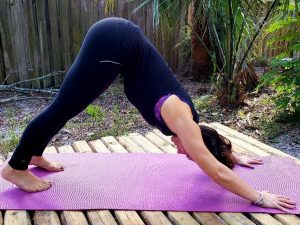A Look at Yoga and Heart Health
By Stephanie Bogden
Heart disease, also known as cardiovascular disease, is one or more conditions of the heart that involves narrowed or blocked blood vessels, structural problems, and/or blood clots, as stated by the American Heart Association. The most common types of cardiovascular disease are damage or disease of the heart’s major blood vessels, improper beating of the heart, sudden, unexpected loss of heart function, and high blood pressure. The Centers for Disease Control and Prevention (CDC) recommends living a healthy lifestyle in order to prevent heart disease, which includes getting enough physical activity. So how does practicing yoga measure up to this recommendation? “Exercise that revs up your heart rate isn’t the only kind of physical activity that can help prevent or manage heart disease. The calming exercise of yoga is good for the heart, too,” states John Hopkins Medicine in an article titled, “The Yoga-Heart Connection.”
Yoga is a discipline that originated in ancient India which includes breath control, physical postures, and simple meditation. The practice of yoga has been known to have many health benefits, including a decrease in stress and anxiety. This is good news for individuals with heart disease because a decrease in stress means a decrease in the presence of hormones like cortisol and adrenaline in the blood. Cortisol and adrenaline narrow the arteries and increase blood pressure. Therefore, practicing yoga may help decrease blood pressure, as well as blood cholesterol, blood glucose levels, and heart rate. Julie Corliss, the executive editor for Harvard Health Publishing, wrote, “A review of yoga and cardiovascular disease published in the European Journal of Preventive Cardiology indicates that yoga may help lower heart disease risk as much as conventional exercises, such as walking.”
Here are three great yoga pose suggestions for a healthy heart:
- Janu Sirsasana (Head-to-Knee Forward Fold)
- Sit on the floor with your legs out in front of you. Keeping the right leg extended forward, bend the left knee out to the side and place the bottom of the left foot against the right inner thigh. Inhale reaching the arms up overhead and exhale lengthen the spine to fold forward over your right leg into a comfortable stretch. You can stay breathing in this pose for a few minutes before transitioning to the other side.

- Setu Bandha Sarvangasana (Bridge Pose)
- Lie supine on the floor with knees bent and feet approximately a fist distance apart. Slide the heels in toward the glutes and allow the palms of your hands to rest down by your hips. Gently tuck the shoulder blades underneath the spine so the heart center feels open. Press the heels and shoulders down to lift the hips up off of the floor. Take a few deep breaths in this position while mindfully energizing the inner thighs. When you are ready to exit the posture, articulate through the spine as you lower one vertebra down at a time until the pelvis has grounded.

- Adho Mukha Svanasana (Downward-Facing Dog)
- Begin on your hands and knees with your knees placed directly underneath your hips. Extend the hands forward on the floor slightly in front of the shoulders, spreading all ten fingers wide and equally distributing your weight across the hands. Then tuck your toes under and float your hips up by slowly extending the knees until your body is in an upside-down V formation. Relax your heels toward the ground and slide your shoulder blades toward your tailbone. Feel the length in your spine as you hold this posture for five to eight breaths. Always consult your doctor before starting new physical activities, including a yoga practice. For more information on yoga and heart health, please refer to the works cited for this article below.

- References: John Hopkins Medicine, The Yoga-Heart Connection, https://www.hopkinsmedicine.org/health/healthy_heart/move_more/the-yoga-heart-connectionCorliss, Julie 2015, More than a stretch: Yoga’s benefits may extend to the heart, Harvard Health Publishing, accessed 28 February 2017, https://www.health.harvard.edu/blog/more-than-a-stretch-yogas-benefits-may-extend-to-the-heart-201504157868American Heart Association 2016, Exercise Mind and Body with Yoga and Mindful Movement, assessed 9 January 2017, https://www.heart.org/en/healthy-living/healthy-lifestyle/mental-health-and-wellbeing/exercise-mind-and-body-with-yoga-and-mindful-movement
- Call 646.592.0782 to reserve a private lesson or visit www.caribbeankarmadr.com


